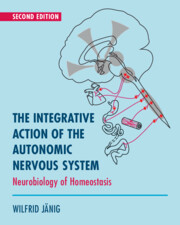Book contents
- The Integrative Action of the Autonomic Nervous System
- Reviews
- The Integrative Action of the Autonomic Nervous System
- Copyright page
- Dedication
- Contents
- Foreword to the Second Edition
- Foreword to the First Edition
- Preface
- Abbreviations
- Introduction The Autonomic Nervous System and the Regulation of Body Functions
- Part I The Autonomic Nervous System: Functional Anatomy and Interoceptive Afferents
- Part II Functional Organization of the Peripheral Autonomic Nervous System
- Part III Transmission of Signals in the Peripheral Autonomic Nervous System
- Part IV Representation of the Autonomic Nervous System in the Spinal Cord and Lower Brain Stem
- Part V The Centers of Homeostasis in the Mesencephalon and Hypothalamus and Their Telencephalic Control
- Chapter 11 Integration of Autonomic Regulation in the Upper Brain Stem and Limbic–Hypothalamic Centers: A Summary
- Epilogue The Autonomic Nervous System in Future Research: Some Personal Views
- Index
- References
Epilogue - The Autonomic Nervous System in Future Research: Some Personal Views
Wilfrid Jänig, Elspeth M. McLachlan
from Part V - The Centers of Homeostasis in the Mesencephalon and Hypothalamus and Their Telencephalic Control
Published online by Cambridge University Press: 16 July 2022
- The Integrative Action of the Autonomic Nervous System
- Reviews
- The Integrative Action of the Autonomic Nervous System
- Copyright page
- Dedication
- Contents
- Foreword to the Second Edition
- Foreword to the First Edition
- Preface
- Abbreviations
- Introduction The Autonomic Nervous System and the Regulation of Body Functions
- Part I The Autonomic Nervous System: Functional Anatomy and Interoceptive Afferents
- Part II Functional Organization of the Peripheral Autonomic Nervous System
- Part III Transmission of Signals in the Peripheral Autonomic Nervous System
- Part IV Representation of the Autonomic Nervous System in the Spinal Cord and Lower Brain Stem
- Part V The Centers of Homeostasis in the Mesencephalon and Hypothalamus and Their Telencephalic Control
- Chapter 11 Integration of Autonomic Regulation in the Upper Brain Stem and Limbic–Hypothalamic Centers: A Summary
- Epilogue The Autonomic Nervous System in Future Research: Some Personal Views
- Index
- References
Summary
In the field of the autonomic nervous system, the most exciting future research developments are likely to be, on the one hand, in the subcellular world and, on the other hand, in the world of the brain’s control of the body’s multicellular machines by way of individual neural programs into a unity of somatomotor, autonomic and neuroendocrine behavior. Today we would rephrase the title of Cannon’s book The Wisdom of the Body to The Wisdom of the Brain in Regulating the Body. It is now clear that a dichotomous concept of the autonomic nervous system divided into sympathetic and parasympathetic and being antagonistically organized, could never explain how the brain controls the body’s organs and tissues.
- Type
- Chapter
- Information
- The Integrative Action of the Autonomic Nervous SystemNeurobiology of Homeostasis, pp. 397 - 402Publisher: Cambridge University PressPrint publication year: 2022



